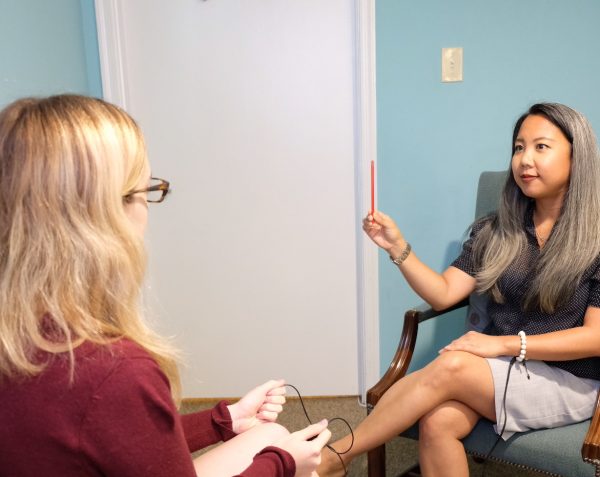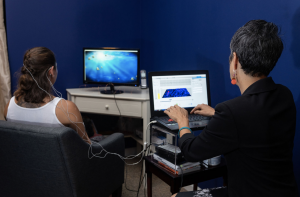
The following is an excerpt from Live Empowered! by Dr. Julie Lopez, founder of The Viva Center.
Common Misconceptions about Brain-Based Therapy
There are many misconceptions about brain-based therapy. However, as is often the case, hearing about these approaches to treatment and actually experiencing them are two different things. The following are the three most common misconceptions my clients have shared.
Misconception #1: You Have To Be Able to Pinpoint and Recall Distressing Events to Reprogram Neural Networks
In the past, people have felt like they have to know the story of their distress in order to get over it. They may have thought that without intellectually knowing the data, they could never heal from it. Today, we know that is not the case based on the work of Sandra Paulsen and her extensive studies of implicit memory.
You don’t have to know the facts of your story to be able to reprogram the symptoms or the outcomes. You don’t have to know the facts of your symptoms’ origins, and you don’t have to do the analysis. The code in your implicit memory system can be changed without the need to understand it or analyze it. This reality is a golden ticket for those without access to their history. It also saves countless hours and dollars in treatment understanding this truth. Although an intellectual understanding can be very grounding, it is not required to heal or make changes in daily performance or well-being.
Misconception #2: In Order for Trauma to Be Healed, It Must Be Relived and Retold
 Countless clients have said they were initially reluctant to work on traumatic experiences of any kind because they didn’t want to relive the disappointments, heartaches, or terrors of their lives, especially considering how hard they had worked day in and day out to forget about those unfortunate circumstances. Most clients had consciously or unconsciously made pacts with themselves not to dwell on what couldn’t be changed.
Countless clients have said they were initially reluctant to work on traumatic experiences of any kind because they didn’t want to relive the disappointments, heartaches, or terrors of their lives, especially considering how hard they had worked day in and day out to forget about those unfortunate circumstances. Most clients had consciously or unconsciously made pacts with themselves not to dwell on what couldn’t be changed.
With brain- or body-based therapeutic approaches, it is not necessary to relive overwhelming experiences in order to heal from them. Although there may be parts of experiences that are recalled in the process, it is not necessary for reprogramming.
Brain- and body-based therapies do not operate on linear recounting or recall. During a session, you may experience a flash of memory from time to time, but that’s temporary. The work takes place primarily within your neural networks. The experience is different for everyone, but any memories tend to go by in a fast, nonsensical way—a far cry from having to relive a painful experience.
Misconception #3: Everyone’s Experience Is the Same
Our neural networks are fascinatingly complex systems, each as unique to the individual as their fingerprints. Because of the complex processes in which these networks are laid, the experience and delivery of brain-based therapy is different from person to person and leads to different outcomes.
Practitioners can see the difference in these client experiences with brain- or body-based therapeutic work firsthand. Some clients exhibit some form of outward sign of processing: changes in breathing, physical tics, or uncontrollable laughing, shaking, or rocking. Sometimes, the experience doesn’t bring about a physical response at all. Clients sometimes report more visual processing or a series of sounds or feelings. Whatever the case for the client, the general protocols of how the treatments are administered by the practitioner remain the same and ultimately bring about desired outcomes.
How Brain-Based Therapy Works
Brain-based therapy is a rich and growing field. As one might expect when working with neural networks, each methodology is a nuanced, complicated process. However, it’s also client-directed. Regardless of methodology, practitioners at my center use the following high-level framework to guide their process.
Step #1: Develop Rapport and Trust for the Process
The cornerstone for effective therapeutic work is in developing both connection and safety within the relationship. I don’t mean general trust, but rather that type of feeling that comes  from deeply understanding on every level (especially subconsciously) that you are in good hands. This is a foundation for doing this direct work with implicit memory, and the time it takes to establish it can vary from person to person. For example, if a client has had negative experiences with trust in general, the process can be longer than for a person who has had close, consistent, and dependable people in their lives.
from deeply understanding on every level (especially subconsciously) that you are in good hands. This is a foundation for doing this direct work with implicit memory, and the time it takes to establish it can vary from person to person. For example, if a client has had negative experiences with trust in general, the process can be longer than for a person who has had close, consistent, and dependable people in their lives.
Step #2: Understand the Lay of the Land
Understanding a person’s general history and life experiences is very important in this type of delicate work—both for the client and for the practitioner. Ideally, when working nonverbally, a client has internal resources that can be called upon should unknown pockets of experience come up. Remember that this is not a linear process. It is also not verbal. The clinician needs to be aware of a client’s abilities and limitations when it comes to tolerating distress and negotiating overwhelming terrain.
Sometimes in this part of the process, the clinician will decide that it is in the best service of the work to take time to build internal and external resources for the client. Internal resources are things like health practices—exercise, meditation, nutrition, and sleep routines—as well as simple at-home therapeutic techniques to teach the client how to help their system grow in its ability to regulate. External resources are supports like online support forums, books, people, groups, and community to build a client’s options for help and well-being outside of themselves.
Step #3: Identify the Problem
When people want to change something, they often speak in terms of their lives and what they want to accomplish. “Instead of missing that promotion because I’m not getting high ratings from the people I manage, I want to be rated better and do things that will make me a better manager.” Or “I am really trying to take my company to a new level, and I need to improve my discipline and ability to focus.” Or “I would be happier if, instead of waking up five times a night, I could sleep through the night.” Or “Instead of pushing my partner away, I would like to be intimate with them.”
want to accomplish. “Instead of missing that promotion because I’m not getting high ratings from the people I manage, I want to be rated better and do things that will make me a better manager.” Or “I am really trying to take my company to a new level, and I need to improve my discipline and ability to focus.” Or “I would be happier if, instead of waking up five times a night, I could sleep through the night.” Or “Instead of pushing my partner away, I would like to be intimate with them.”
We look at the situation that the client wants to manifest or change and work together to discover how any core messaging or functioning in their implicit memory could be sabotaging whatever it is they’re trying to accomplish. These core beliefs are the entry points to get into the implicit memory networks—the encoded experiences and fears that send messages such as “I’m going to die,” “I’m not safe,” “I’m disgusting,” or “I’m a failure.”
Please note that oftentimes when the targeted networks were formed from preconscious, preverbal material, we may be using body sensations as the entry vehicle. For example, one client of mine presented with OCD symptoms around clothing order in her closet. She’d had some experiences before she was two years old that ended up being responsible for her extreme distress when things were out of order (in her idea of things). She did not remember those early years of her life as an infant/toddler when her parents took her out of their war-torn country. She didn’t recall even her first years in relative safety as a refugee. But the precipitant to the hours she would spend aligning her hangers in her closet and making sure each clothing item was properly oriented and in order of color, style, and season, her body had very stark sensations. Her stomach would be in knots. Sometimes, she would develop a specific type of piercing headache. These bodily experiences became our entry point into the implicit memory network associated with her extreme need for order.
Usually, these encoded messages don’t manifest consciously. For instance, a woman may shower every day, contribute to the well-being of the planet, and engage in healthy relationships with friends and partners. However, encoded deep in her neural pathways is the idea that she is disgusting and worthless—an idea that has plagued her unconscious since a difficult experience she had as a young girl. For the most part, she can get by just fine even with this encoded message, but one day, it might sabotage an important goal or relationship. For instance, she might hold herself back from submitting a large, high-dollar proposal, or she might think twice about applying to speak on a big stage. To her, the foot dragging seems illogical. She wants to do these things, but the encoded messages in her neural networks are driving the show without her conscious consent or intellectual understanding.
Step #4: Access the Hidden Control Panel
Once a client has shared as much information as they can, we can then be better equipped to find the more sensor data that is likely an indicator of what codes may be in the hidden panel related to the therapeutic goal. This hidden panel rarely operates in the conscious mind, but because it’s always running in the background, it can dramatically impact a person’s mood, physical well-being, and ability to perform in their life.
The specifics of the entry point don’t matter as much as the fact that there is an entry point. That said, certain entry points for different therapeutic approaches are contraindicated. If someone says they have a history of migraines, for instance, a practitioner will want more  information before proceeding. What is their medical history? Is the client on any medications, and do they have any allergies? Do they have a history of anything more serious, such as seizures? Depending on the answers, a practitioner may choose not to use EMDR, instead electing to use a method of bilateral stimulation that will be tactile rather than visual or choosing Brainspotting or Neurofeedback.
information before proceeding. What is their medical history? Is the client on any medications, and do they have any allergies? Do they have a history of anything more serious, such as seizures? Depending on the answers, a practitioner may choose not to use EMDR, instead electing to use a method of bilateral stimulation that will be tactile rather than visual or choosing Brainspotting or Neurofeedback.
Step #5: Reprogram the Network
Once we have tapped into a client’s hidden control panel, we can make profound changes in the ways they experience their daily lives. Often, the strongest core beliefs result from early childhood experiences, a fact that was reinforced for me time and again during my work at
the rape crisis center. Although each client’s story was unique, involving different people, scenarios, and disappointments, the more stories I heard, the more apparent it became to me that the earlier the experience, the deeper the impact.
A horrifying experience such as rape, for instance, is traumatic at any age. However, the earlier the trauma, the more far-reaching implications it can have into different areas of a person’s life. Early experiences create important building blocks in our internal quest to thrive in our lives. Subsequent experiences then build on what is already known by the brain. Adding to this, the earlier the experience, the more it tends to be spread out across various neural networks—and the more complicated it can be for clients to reprocess and reprogram the experience.
This step involves utilizing information already available to the client, as well as experiences that the client has had that have given contradictory data to their system, especially data in the service of their goals. During this time period, no matter the therapeutic approach, more adaptive data is discovered, installed, and reprogrammed into the implicit memory system so that a new code consistent with supporting the client’s goals are the new default belief.
Step #6: Make Any Follow-Up Behavioral Changes Needed
Again, no matter the brain- or body-based approach being used, once there is a new set point for functioning, any new behaviors that are necessary to accomplish that original goal must be incorporated. Different than before, now there is not data in the implicit memory serving to derail progress. For the client who came in saying she wanted to get better performance ratings at work and thereby not be passed by for the next promotion, she would now find it much easier to implement any communications adjustments, relationship improvements, or visibility practices toward that stated goal.
Just because someone’s implicit memory has been rewired, it does not mean that they suddenly have the modeling, practice, and conditioning needed to be their
own best advocate. This final step is about working this behavioral aspect of any desired change.
To learn more about brain-based therapies, check out Dr. Julie’s book, Live Empowered: Rewire Your Brain’s Implicit Memory to Succeed in Business, Love, and Life. To schedule an appointment for EMDR, Brainspotting, or Neurofeedback at The Viva Center, click here.

